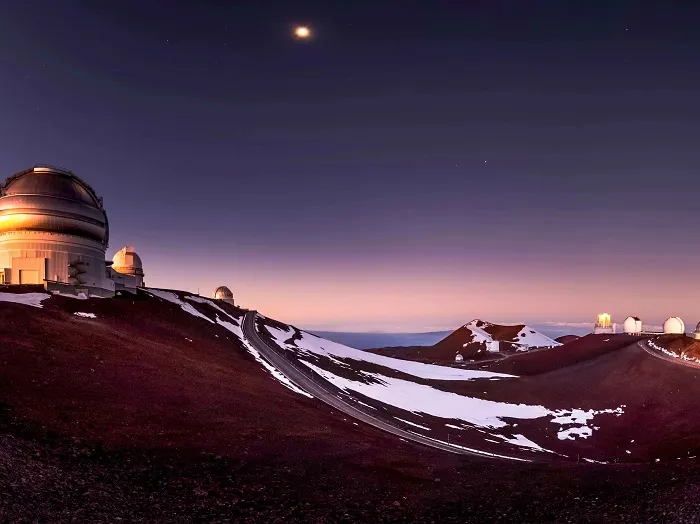Hawaii, the paradise island renowned for its white sand beaches and majestic volcanic landscapes, holds another treasure: a sparkling night sky. With its unique geographical location, low light pollution, and clear air, Hawaii is one of the most ideal destinations in the world for stargazing and cosmic exploration. This article will guide you to the most amazing locations in Hawaii where you can admire the magical beauty of the night sky.
From towering mountain peaks to pristine beaches, Hawaii offers countless opportunities to connect with the vast universe. Let’s explore unique stargazing spots and prepare for a memorable astronomical adventure on this beautiful island.
Mauna Kea: The Sacred and Majestic “White Mountain”
Mauna Kea, meaning “White Mountain” in Hawaiian, is not only the highest peak in Hawaii but also one of the tallest mountains in the world when measured from its base on the ocean floor. Rising over 4,200 meters (13,800 feet) above sea level, Mauna Kea boasts ideal conditions for astronomical observation: dry air, clear skies, and minimal light pollution.

Mauna Kea holds deep cultural and spiritual significance for native Hawaiians. The mountain is considered the realm of deities and a sacred place. Today, Mauna Kea is also a world-leading center for astronomical research, with numerous state-of-the-art observatories built on its summit.
Mauna Kea Observatories: A Gateway to the Cosmos
The Mauna Kea Observatories complex hosts numerous large telescopes from around the world. Thanks to its prime location and exceptional viewing conditions, astronomers here have made significant discoveries about the universe.

Visitors can explore the Mauna Kea Visitor Information Station (VIS) located at an elevation of 2,800 meters (9,200 feet). Here, you can learn about astronomy, the universe, and the history of Mauna Kea. The center also hosts free stargazing programs at night, where you can marvel at the beauty of the night sky through telescopes.
Important Notes for Visiting Mauna Kea:
- Acclimatize to the Altitude: The altitude of Mauna Kea can cause altitude sickness. Spend time acclimatizing at the VIS before heading to the summit.
- Prepare Warm Clothing: Temperatures at the summit of Mauna Kea can drop below freezing, even in summer.
- Not Suitable for Children Under 16: Due to the risk of altitude sickness, children under 16 are not allowed to ascend to the summit.
- Book a Stargazing Tour: If you want a professional stargazing experience, consider booking a tour with local companies.
Haleakalā National Park: The Mystical “House of the Sun”
Located on the island of Maui, Haleakalā National Park is another exceptional stargazing destination in Hawaii. Haleakalā, meaning “House of the Sun” in Hawaiian, is a dormant volcano with a massive crater.
Rising over 3,000 meters (10,000 feet), Haleakalā also offers clear skies and low light pollution, creating ideal conditions for stargazing. Visitors can drive to the summit of Haleakalā to watch the sunrise or sunset, and then stay overnight to admire the sparkling night sky.
Notable Stargazing Spots in Haleakalā:
- Haleakalā Visitor Center: Located near the summit, the center provides information about the park, astronomy, and stargazing programs.
- Hosmer Grove Campground: This campground is located at a lower elevation, with more trees and less wind than the summit. It’s a good option if you want to camp overnight and stargaze.
- Haleakalā Summit: The summit is the highest point in the park and offers panoramic views of the night sky.
Pristine Beaches: Immerse Yourself in Nature and the Cosmos
Beyond the mountain peaks, Hawaii also boasts numerous pristine beaches where you can stargaze right from the shore. These beaches are often located away from urban areas, with minimal light pollution, offering a tranquil space to relax and appreciate the beauty of the cosmos.
Some Ideal Beaches for Stargazing in Hawaii:
- Mauna Kea Beach (Big Island): Famous for its fine white sand and clear waters, Mauna Kea Beach is an excellent spot for stargazing after a swim.
- Polihale Beach (Kauai): Located on the west coast of Kauai, Polihale Beach is one of the longest beaches in Hawaii and has very dark night skies.
- Waimea Bay (Oahu): Famous for its large waves in winter, Waimea Bay is also a good location for stargazing in the summer when the ocean is calmer.
Tips for an Amazing Stargazing Experience in Hawaii
- Check the Weather Forecast: Ensure clear skies before you plan your stargazing trip.
- Find a Dark Location: Stay away from urban areas and find locations with minimal light pollution.
- Use a Red Flashlight: Red light helps you see in the dark without affecting your night vision for stargazing.
- Bring Binoculars or a Telescope: If possible, bring binoculars or a telescope for a closer view of celestial objects.
- Download a Star Map App: Star map apps can help you identify constellations, planets, and other celestial bodies in the sky.
- Learn About Astronomy: Reading books or watching documentaries about astronomy can enhance your understanding of what you’re seeing in the night sky.
Hawaii is not only a popular tourist destination with stunning natural landscapes but also a paradise for astronomy enthusiasts. With its clear night skies and minimal light pollution, Hawaii offers unforgettable stargazing experiences. Plan your trip to Hawaii and discover the magical beauty of the universe today!